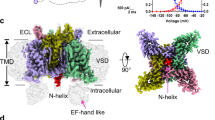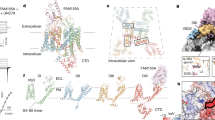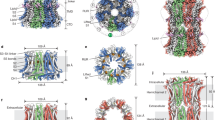Abstract
Sodium channels initiate the electrical cascade responsible for cardiac rhythm, and certain life-threatening arrhythmias arise from Na+ channel dysfunction. We propose a novel mechanism for modulation of Na+ channel function whereby calcium ions bind directly to the human cardiac Na+ channel (hH1) via an EF-hand motif in the C-terminal domain. A functional role for Ca2+ binding was identified electrophysiologically, by measuring Ca2+-induced modulation of hH1. A small hH1 fragment containing the EF-hand motif was shown to form a structured domain and to bind Ca2+ with affinity characteristic of calcium sensor proteins. Mutations in this domain reduce Ca2+ affinity in vitro and the inactivation gating effects of Ca2+ in electrophysiology experiments. These studies reveal the molecular basis for certain forms of long QT syndrome and other arrhythmia-producing syndromes, and suggest a potential pharmacological target for antiarrhythmic drug design.
This is a preview of subscription content, access via your institution
Access options
Subscribe to this journal
Receive 12 print issues and online access
$189.00 per year
only $15.75 per issue
Buy this article
- Purchase on Springer Link
- Instant access to full article PDF
Prices may be subject to local taxes which are calculated during checkout



Similar content being viewed by others
References
Echt, D.S. et al. Mortality and morbidity in patients receiving encainide, flecainide, or placebo. N. Engl. J. Med. 324, 781–788 (1991).
Bennett, P.B., Yazawa, K., Naomasa, M. & George, A.L. Molecular mechanism for an inherited cardiac arrhythmia. Nature 376, 683–685 (1995).
Chen, Q. et al. Genetic basis and molecular mechanism for idiopathic ventricular fibrillation. Nature 392, 293–296 (1998).
Dumaine, R. et al. Multiple mechanisms of Na+ channel-linked long-QT syndrome. Circ. Res. 78, 916–924 (1996).
Wang, D.W., Yazawa, K., George, A.L. & Bennett, P.B. Characterization of human cardiac Na+ channel mutations in the congenital long QT syndrome. Proc. Natl. Acad. Sci. 93, 13200–13205 (1996).
Bezzina, C. et al. A single Na(+) channel mutation causing both long-QT and Brugada syndromes. Circ. Res. 85, 1206–1213 (1999).
Benhorin, J. et al. Identification of a new SCN5A mutation, D1840G, associated with the long QT syndrome. Mutations in brief no. 153. Online. Hum. Mutat. 12, 72 (1998).
An, R.H. et al. Novel LQT-3 mutation affects Na+ channel activity through interactions between α- and β1-subunits. Circ. Res. 83, 141–146 (1998).
Wehrens, X.H., Abriel, H., Cabo, C., Benhorin, J. & Kass, R.S. Arrhythmogenic mechanism of an LQT-3 mutation of the human heart Na(+) channel α-subunit: a computational analysis. Circulation 102, 584–590 (2000).
Cormier, J.W., Rivolta, I., Tateyama, M., Yang, A.-S. & Kass, R.S. Secondary structure of the human cardiac Na+ channel C terminus: evidence for a role of helical structures in modulation of channel inactivation. J. Biol. Chem. 277, 9233–9241 (2002).
Altschul, S.F., Gish, W., Miller, W., Myers, E.W. & Lipman, D.J. Basic local alignment search tool. J. Mol. Biol. 215, 403–410 (1990).
Altschul, S.F. et al. Gapped BLAST and PSI-BLAST: a new generation of protein database search programs. Nucleic Acids Res. 25, 3389–3402 (1997).
Peterson, B.Z. et al. Critical determinants of Ca(2+)-dependent inactivation within an EF-hand motif of L-type Ca(2+) channels. Biophys. J. 78, 1906–1920 (2000).
Tan, H.L. et al. A calcium sensor in the sodium channel modulates cardiac excitability. Nature 415, 442–447 (2002).
Deschenes, I. et al. Isoform-specific modulation of voltage-gated Na(+) channels by calmodulin. Circ. Res. 90, E49–E57 (2002).
Lewit-Bentley, A. & Rety, S. EF-hand calcium-binding proteins. Curr. Opin. Struct. Biol. 10, 637–643 (2000).
Shaw, G.S., Hodges, R.S. & Sykes, B.D. Calcium-induced peptide association to form an intact protein domain: 1H NMR structural evidence. Science 249, 280–283 (1990).
Linse, S. & Forsen, S. Determinants that govern high-affinity calcium binding. Adv. Second Messenger Phosphoprotein Res. 30, 89–151 (1995).
Strynadka, N.C. & James, M.N. Crystal structures of the helix-loop-helix calcium-binding proteins. Annu. Rev. Biochem. 58, 951–998 (1989).
Shaw, R.M. & Rudy, Y. Electrophysiologic effects of acute myocardial ischemia. A mechanistic investigation of action potential conduction and conduction failure. Circ. Res. 80, 124–138 (1997).
Veldkamp, M.W. et al. Two distinct congenital arrhythmias evoked by a multidysfunctional Na(+) channel. Circ. Res. 86, E91–E97 (2000).
Tsien, R.Y. New calcium indicators and buffers with high selectivity against magnesium and protons: design, synthesis, and properties of prototype structures. Biochemistry 19, 2396–2404. (1980).
Christova, P., Cox, J.A. & Craescu, C.T. Ion-induced conformational and stability changes in Nereis sarcoplasmic calcium binding protein: evidence that the APO state is a molten globule. Proteins 40, 177–184 (2000).
Veeraraghavan, S. et al. Structural independence of the two EF-hand domains of caltractin. J. Biol. Chem. 277, 28564–28571 (2002).
Theret, I., Baladi, S., Cox, J.A., Sakamoto, H. & Craescu, C.T. Sequential calcium binding to the regulatory domain of calcium vector protein reveals functional asymmetry and a novel mode of structural rearrangement. Biochemistry 39, 7920–7926 (2000).
Tateyama, M., Rivolta, I., Clancy, C.E. & Kass, R.S. Modulation of cardiac sodium channel gating by protein kinase A can be altered by disease-linked mutation. J. Biol. Chem. 18, 18 (2003).
Zhou, J. et al. Feedback inhibition of Ca2+ channels by Ca2+ depends on a short sequence of the C terminus that does not include the Ca2+-binding function of a motif with similarity to Ca2+-binding domains. Proc. Natl. Acad. Sci. USA 94, 2301–2305. (1997).
Wu, Y., Dzhura, I., Colbran, R.J. & Anderson, M.E. Calmodulin kinase and a calmodulin-binding 'IQ' domain facilitate L-type Ca2+ current in rabbit ventricular myocytes by a common mechanism. J. Physiol. 535, 679–687 (2001).
Zuhlke, R.D., Pitt, G.S., Deisseroth, K., Tsien, R.W. & Reuter, H. Calmodulin supports both inactivation and facilitation of L-type calcium channels. Nature 399, 159–162 (1999).
Wei, J. et al. Congenital long-QT syndrome caused by a novel mutation in a conserved acidic domain of the cardiac Na+ channel. Circulation 99, 3165–3171 (1999).
Tan, H.L. et al. A sodium channel mutation causes isolated cardiac conduction disease. Nature 409, 1043–1047 (2001).
Bers, D.M., Patton, C.W. & Nuccitelli, R. A practical guide to the preparation of Ca2+ buffers. Methods Cell Biol. 40, 3–29 (1994).
Livingstone, C.D. & Barton, G.J. Protein sequence alignments: a strategy for the hierarchical analysis of residue conservation. Comput. Appl. Biosci. 9, 745–756. (1993).
Jones, D.T., Taylor, W.R. & Thornton, J.M. A new approach to protein fold recognition. Nature 358, 86–89 (1992).
Laskowski, R., MacArthur, M.W., Moss, D.S & Thornton, J.M. PROCHECK: a program to check the stereochemical quality of protein structures. J. Appl. Crystallogr. 26, 283–291 (1993).
Andre, I. & Linse, S. Measurement of Ca2+-binding constants of proteins and presentation of the CaLigator software. Anal. Biochem. 305, 195–205 (2002).
Acknowledgements
We thank S. Stepanovic for invaluable technical assistance, L. Mizoue for providing pSV278 and N. Pokala (University of California Berkeley) for his generous gift of pSV272. This work was supported by operating grants (to M.E.A., T.P.L., W.J.C. and J.R.B.) from the US National Institutes of Health and a predoctoral fellowship from the American Heart Association.
Author information
Authors and Affiliations
Corresponding authors
Ethics declarations
Competing interests
The authors declare no competing financial interests.
Supplementary information
Rights and permissions
About this article
Cite this article
Wingo, T., Shah, V., Anderson, M. et al. An EF-hand in the sodium channel couples intracellular calcium to cardiac excitability. Nat Struct Mol Biol 11, 219–225 (2004). https://doi.org/10.1038/nsmb737
Received:
Accepted:
Published:
Issue Date:
DOI: https://doi.org/10.1038/nsmb737
This article is cited by
-
Properties of Calmodulin Binding to NaV1.2 IQ Motif and Its Autism-Associated Mutation R1902C
Neurochemical Research (2021)
-
Sodium current inhibition following stimulation of exchange protein directly activated by cyclic-3′,5′-adenosine monophosphate (Epac) in murine skeletal muscle
Scientific Reports (2019)
-
The voltage-gated sodium channel EF-hands form an interaction with the III-IV linker that is disturbed by disease-causing mutations
Scientific Reports (2018)
-
Effects of ageing on pro-arrhythmic ventricular phenotypes in incrementally paced murine Pgc-1β −/− hearts
Pflügers Archiv - European Journal of Physiology (2017)
-
The RyR2-P2328S mutation downregulates Nav1.5 producing arrhythmic substrate in murine ventricles
Pflügers Archiv - European Journal of Physiology (2016)



